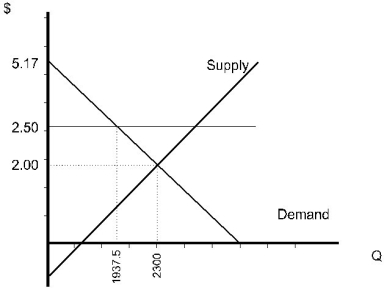Asked by Abigail Orozco on Jul 27, 2024

Verified
The supply and demand curves for corn are as follows:
QD = 3,750 - 725P
QS = 920 + 690P,
where Q = millions of bushels and P = price per bushel.
a. Calculate the equilibrium price and quantity that would prevail in the free market.
b. The government has imposed a $2.50 per bushel support price. How much corn will the government be forced to purchase?
c. Calculate the loss in consumer surplus that would occur under the support program.
Support Price
A price level set by governments in order to maintain the market price of a good or service at a particular minimum level to protect producers.
Consumer Surplus
The difference between what consumers are willing to pay for a good or service versus what they actually pay, measuring the benefit to consumers from participation in the market.
Equilibrium Price
The price at which the quantity of a good or service demanded equals the quantity supplied, resulting in market equilibrium.
- Calculate and interpret equilibrium price and quantity in free markets and under government intervention.
- Evaluate the welfare implications of trade restrictions and government interventions in the market.

Verified Answer
3,750 - 725P = 920 + 690P
2,830 = 1,415P
P = 2.00
QD = 3,750 - 725(2) = 2,300
b.To solve for government quantity, QG, we realize that:
QG = QS - QD
920 + 690P = 3750 - 725P + QG
QG = 1415P - 2830
Quantity supplied at the support price of $2.50 is:
QS = 920 + 650(2.50)
QS = 2645
Quantity demanded at the support price of $2.50 is:
QD = 3750 - 725(2.50)
QD = 1937.50
Government quantity purchased is then 707.5 bushels.
c.Solve supply and demand for P in terms of Q:
QD = 3750 - 725P
P = 5.17 - 0.0014Q
QS = 920 + 690P
P = -1.33 + 0.00145Q
 QD at P = 2.50
QD at P = 2.50QD = 3750 - 725(2.50)
QD = 1937.50
C.S. under free market: = 0.5(5.17 - 2.00) × 2300
C.S. under free market = 3645.5
C.S. under support price: = 0.5(5.17 - 2.50) × 1937.50
C.S. under price support = 2586.56
Price support results in a loss of $1058.94 in consumer surplus.

Learning Objectives
- Calculate and interpret equilibrium price and quantity in free markets and under government intervention.
- Evaluate the welfare implications of trade restrictions and government interventions in the market.
Related questions
The Market for All-Leather Men's Shoes Is Served by Both ...
In General, the Deadweight Loss Associated with an Import Tariff ...
The Market Demand and Supply Functions for Pork Are ...
The Demand and Supply Functions for Pizza in the Local ...
Consider a Competitive Market with Supply and Demand Curves Expressed ...